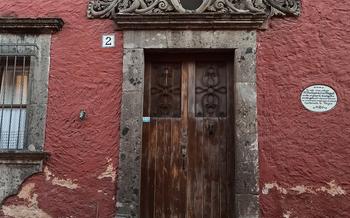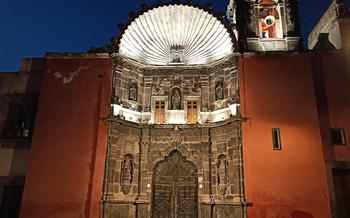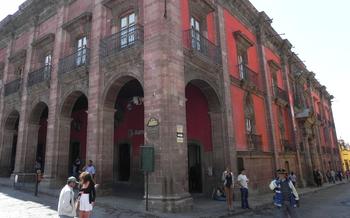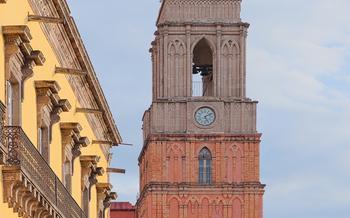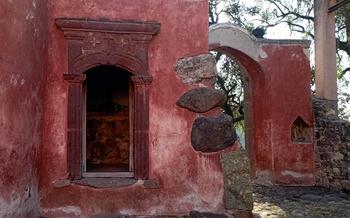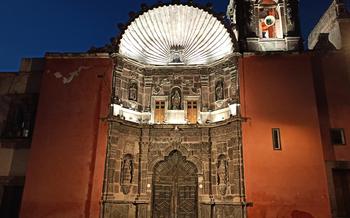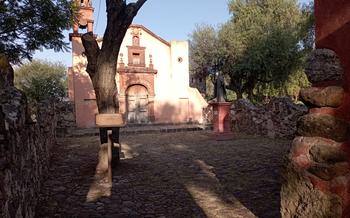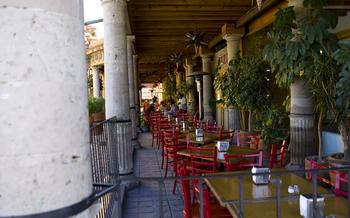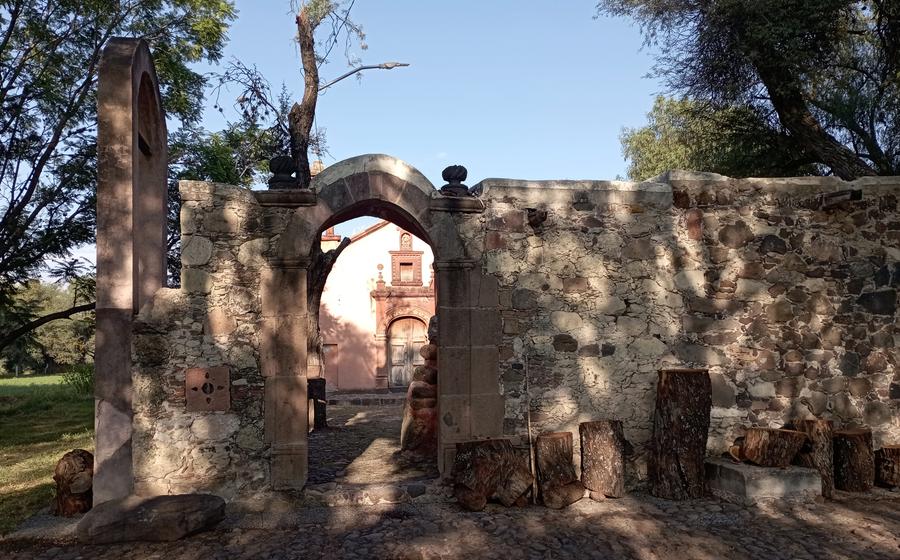
Artisan Market (Mercado de Artesanias)
- History of the Artisan Market
- Types of Goods Sold
- Artisans and Vendors
- Shopping Experience
- Cultural Significance
- Popular Items
- Local Craftsmanship
- Supporting Local Artisans
- Interactive Workshops
- Live Music and Performances
- Food and Drink
- Photography Opportunities
- Accessibility
- Insider Tip:
History of the Artisan Market
The Artisan Market in San Miguel de Allende has a rich and storied history. It was first established in the 16th century, making it one of the oldest markets in Mexico. The original purpose of the market was to provide a place for local artisans and vendors to sell their goods to the residents of San Miguel de Allende. Over time, the market has grown and evolved, and it now attracts visitors from all over the world.
In the early days, the market was held in the main square of San Miguel de Allende. However, as the city grew, the market was moved to its current location on Calle Correo. The market has faced a number of challenges over the years, including fires, earthquakes, and economic downturns. However, it has always managed to survive and thrive.
Today, the Artisan Market is a vibrant and bustling place. It is a popular destination for both locals and tourists alike. The market is a testament to the rich cultural heritage of San Miguel de Allende, and it plays an important role in the city's economy.
Types of Goods Sold
The Artisan Market is a treasure trove of handmade crafts and souvenirs, offering a diverse selection of items that reflect the rich cultural heritage of San Miguel de Allende. Shoppers can find an array of colorful textiles, including hand-woven rugs, embroidered blouses, and intricate tapestries. There is also a wide variety of pottery, from traditional Talavera tiles to whimsical animal figurines. Jewelry lovers will delight in the sparkling array of silver and gemstone pieces, while art enthusiasts can choose from a variety of paintings, sculptures, and prints. In addition to these traditional crafts, the market also features a variety of modern and contemporary items, such as handmade soaps, candles, and leather goods.
Prices at the market vary depending on the type of item and the skill of the artisan. Shoppers can expect to find items ranging from a few dollars to several hundred dollars. Bargaining is acceptable, and it is often possible to get a good deal if you are willing to haggle. However, it is important to remember that the artisans rely on the income from their sales to support themselves and their families, so it is important to be respectful and offer a fair price.
Artisans and Vendors
The artisans and vendors who sell at the Artisan Market in San Miguel de Allende come from all walks of life. Some are local residents who have been making and selling their crafts for generations, while others are newcomers who have been drawn to the city's vibrant art scene.
Many of the artisans are self-taught, having learned their skills from family members or friends. Others have attended formal art schools or workshops. Regardless of their background, all of the artisans share a passion for their work and a desire to create beautiful, unique pieces that reflect the culture and traditions of San Miguel de Allende.
The vendors who sell at the market are a diverse group as well. Some are the artisans themselves, while others are shopkeepers who buy their products from local artisans. There are also a number of food vendors who sell traditional Mexican dishes and snacks.
The artisans and vendors at the Artisan Market are friendly and welcoming, and they are always happy to chat with visitors about their work. They are also more than willing to bargain on prices, so don't be afraid to haggle a bit.
Shopping Experience
The Artisan Market is a vibrant and lively place, buzzing with activity and energy. The narrow aisles are lined with colorful stalls, each one showcasing a unique array of handcrafted treasures. The air is filled with the sounds of haggling, laughter, and the gentle strumming of guitars.
Navigating the market is a breeze, as the stalls are organized by type of merchandise. Whether you're looking for pottery, textiles, jewelry, or home décor, you'll find it all here. The vendors are friendly and helpful, always willing to share their knowledge about their products and the stories behind their creation.
Be sure to respect the local customs and traditions while shopping at the market. Bargaining is expected, but it should be done in a polite and respectful manner. Don't be afraid to ask questions and learn about the artisans and their work. It's not uncommon for shoppers to develop personal relationships with the vendors, making the shopping experience even more rewarding.
To get the most out of your shopping experience, take your time and browse the stalls leisurely. Don't be afraid to ask questions and interact with the vendors. And be sure to bring cash, as many vendors do not accept credit cards.
Cultural Significance
The Artisan Market is considered a cultural landmark of San Miguel de Allende, representing its rich traditions and heritage. It is a place where the essence of Mexican craftsmanship and artistry comes alive. The market plays a significant role in preserving and promoting the city's unique cultural identity.
Many of the artisans who sell their products at the market are local residents, and the market provides them with a platform to share their skills and creativity with the world. The market also contributes to the city's economy, attracting visitors who come to experience the vibrant atmosphere and purchase one-of-a-kind handmade items.
The Artisan Market is not just a place to shop; it is also a place to learn about Mexican culture and traditions. Visitors can interact with the artisans, learn about the history and techniques behind their crafts, and gain a deeper appreciation for the country's rich artistic heritage.
Popular Items
The Artisan Market is a treasure trove of unique and beautiful handmade items. Some of the most popular items include:
-
Hand-blown glass: San Miguel de Allende is known for its vibrant hand-blown glass, and the market is a great place to find one-of-a-kind pieces, such as vases, plates, and ornaments.
-
Leather goods: The market is also a great place to find high-quality leather goods, such as bags, wallets, and shoes. The leather is often hand-tooled with intricate designs.
-
Textiles: San Miguel de Allende is home to a number of talented textile artisans, and the market is a great place to find beautiful hand-woven rugs, blankets, and clothing.
-
Jewelry: The market is also a great place to find unique and affordable jewelry, such as silver earrings, necklaces, and bracelets.
-
Pottery: San Miguel de Allende is also known for its pottery, and the market is a great place to find colorful and unique pieces, such as plates, bowls, and vases.
Local Craftsmanship
The Artisan Market in San Miguel de Allende is renowned for showcasing the rich and diverse traditional crafts of the region. Visitors can find a wide range of handmade items, each representing a unique aspect of Mexican culture.
Textiles: San Miguel de Allende is well-known for its exquisite textiles, including colorful woven blankets, embroidered garments, and intricate tapestries. These textiles are often made using traditional techniques passed down through generations, such as backstrap weaving and hand embroidery.
Ceramics: The market is also home to a variety of ceramic pieces, from colorful Talavera pottery to traditional clay figurines. These ceramics are often hand-painted with intricate designs, making each piece a unique work of art.
Leather Goods: Artisans at the market create beautiful leather goods, such as bags, wallets, and shoes. The leather is often hand-tooled with intricate designs, showcasing the skill and artistry of the craftsmen.
Jewelry: Visitors can find a wide selection of handmade jewelry at the market, including silver and gold pieces, as well as colorful beaded jewelry. Many of the pieces are inspired by traditional Mexican designs and feature unique gemstones and semi-precious stones.
Metalwork: The market also showcases a variety of metalwork, including intricate iron gates, decorative mirrors, and copper cookware. These metal pieces are often adorned with elaborate designs and demonstrate the skill and craftsmanship of local artisans.
Supporting Local Artisans
The Artisan Market is not just a place to buy souvenirs, it is also a way to support local artisans and preserve traditional crafts. When you buy from the artisans, you are helping to keep their traditions alive and ensuring that these skills are passed down to future generations. You are also helping to support the local economy and create jobs.
Look for the "Hecho en Mexico" label, which guarantees that the product was made in Mexico. Ask the artisans about their products and their stories. Learn about the techniques they use and the materials they work with. The more you know about the artisans and their work, the more you will appreciate the value of their products.
Bargain, but be fair. The artisans rely on the income from their sales to support themselves and their families. Be respectful of their time and effort. If you are not sure about a price, ask the artisan what they would recommend.
By supporting local artisans, you are not only getting a unique and beautiful product, but you are also helping to preserve a valuable cultural heritage.
Interactive Workshops
For those eager to delve deeper into the intricate world of traditional Mexican crafts, the Artisan Market offers a unique opportunity to participate in interactive workshops. These immersive sessions provide visitors with hands-on experience and insights into the techniques and artistry behind various crafts.
From pottery and weaving to jewelry making and woodcarving, the workshops cover a diverse range of disciplines, each led by skilled artisans who share their knowledge and expertise. Participants can choose from a variety of workshops based on their interests and skill level, whether they are complete beginners or seasoned crafters seeking to refine their techniques.
The workshops are typically held in small groups, ensuring personalized attention from the instructors and a chance for participants to ask questions and receive guidance. The cost of the workshops varies depending on the duration and complexity of the craft, but they generally offer an affordable and rewarding experience.
Whether you're a seasoned artisan or simply curious about traditional Mexican crafts, these workshops provide a unique opportunity to learn from the masters, immerse yourself in the creative process, and take home a one-of-a-kind souvenir that you've made yourself.
Live Music and Performances
The Artisan Market in San Miguel de Allende is not just a place to shop for beautiful handicrafts; it's also a vibrant cultural hub where visitors can enjoy live music and performances. On weekends, the market comes alive with the sounds of traditional Mexican music, including mariachi bands, trios, and solo musicians. These talented performers create a festive atmosphere that adds to the overall experience of visiting the market.
In addition to music, visitors can also enjoy a variety of other performances at the market. Traditional Mexican dance troupes often perform, showcasing the country's rich cultural heritage. There are also occasional puppet shows, acrobatic acts, and other forms of street entertainment.
The performances at the Artisan Market are typically free to watch, and they offer a great way to learn more about Mexican culture and traditions. So, be sure to take some time to enjoy the live music and performances when you visit the market. You're sure to be entertained and delighted.
Food and Drink
There is a wide array of food and drink options available at the Artisan Market, catering to diverse tastes and preferences. Local vendors offer a variety of traditional Mexican dishes, including tacos, tamales, enchiladas, and pozole. Fresh fruit juices, aguas frescas, and traditional Mexican beverages like horchata and Jamaica are also popular choices. For those with a sweet tooth, there are plenty of dessert options, such as churros, buñuelos, and traditional Mexican candies. Visitors can enjoy their food and drinks at designated seating areas scattered throughout the market, providing a chance to relax and soak in the lively atmosphere.
Photography Opportunities
Photography enthusiasts will delight in the vibrant colors and unique scenes that the Artisan Market offers. Capturing the essence of the market through the lens of a camera is a rewarding experience. While photography is generally permitted, it's essential to be respectful of the artisans and shoppers and avoid disrupting their activities.
For the best photo opportunities, visit the market during the early morning or late afternoon when the light is soft and golden. Experiment with different angles and perspectives to capture the market's lively atmosphere. Close-up shots of intricate handicrafts, portraits of artisans at work, and panoramic views of the market stalls can all yield stunning results.
Remember to ask permission before photographing individuals, especially if they are working or engaged in a private conversation. Respecting local customs and traditions is crucial to maintaining a harmonious environment for everyone.
Accessibility
The Artisan Market is committed to ensuring that all visitors have a positive and accessible experience. The market is wheelchair accessible, with ramps and elevators available to navigate the different levels. Designated parking spaces for people with disabilities are located nearby, and accessible restrooms are available within the market. The market staff is friendly and accommodating, always willing to assist visitors with any needs they may have.
Insider Tip:
- To avoid crowds, visit the Artisan Market in the morning between 10 am and 12 pm or in the late afternoon from 5 pm to 7 pm when most tourists have left.
- Plan your visit around one of the market's special events or festivals throughout the year, such as the Christmas Market in December or the Day of the Dead Market in November.
- Combine your visit to the market with other nearby attractions, such as the San Miguel de Allende Parish Church, the Alhóndiga de Granaditas, or the Museo Histórico de San Miguel de Allende.
- Consider joining a guided tour of the market to learn more about the history, culture, and traditions of the market and its vendors.

